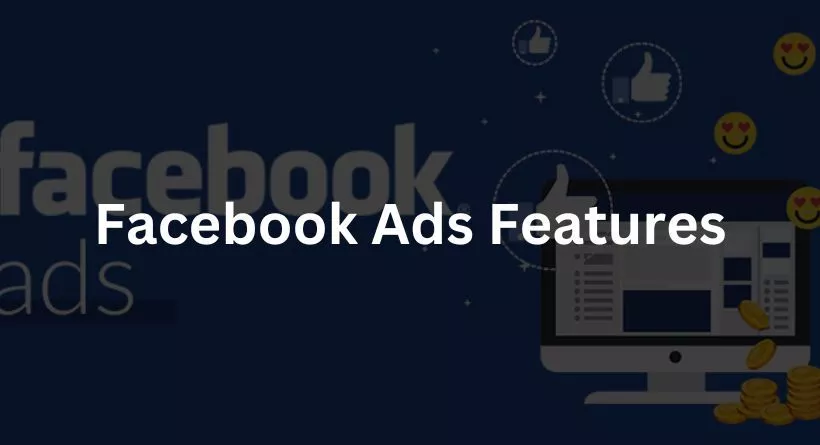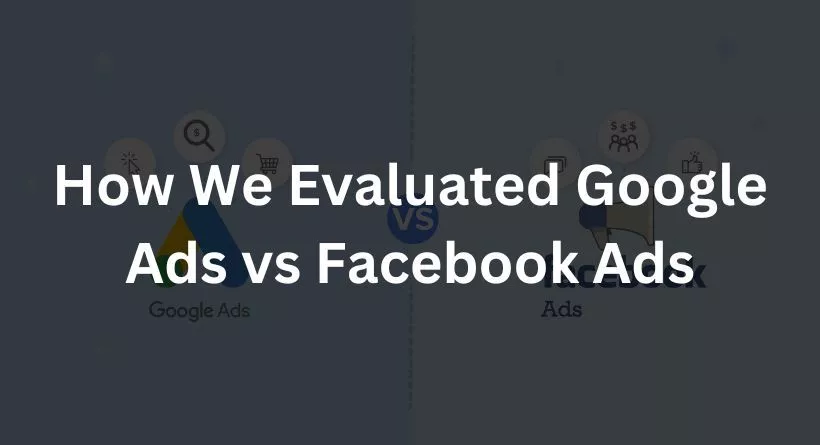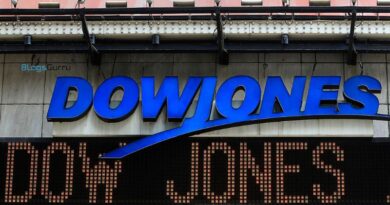Facebook Ads vs Google Ads: Which Is Best for Your Business?
Your target demographic will determine whether you should use Facebook ads or Google ads to increase sales. Use Google Ads to reach out to clients who are actively looking for products like yours and are ready to buy. Utilise Facebook Ads (formerly known as Meta for Business) to inform your target market about your company and any goods or services that may interest them even if they aren’t actively looking for them.
Get AI and data-driven technologies from WebFX to support your advertising strategy. Build your strategy after a free consultation that is specifically customised to your company.
Facebook Ads Pros
- wonderful for increasing brand awareness
- meet with buyers as early as possible
- intelligent audience targeting
- Limit budget expenditures by day, season, or campaign
- Facebook Pixel-based robust performance metrics
Facebook Ads Cons
- difficult to learn
- needs creative assets (like pictures and movies)
- Ad spending can easily waste with bad targeting
- Sometimes it’s difficult to measure the results.
Google Ads Pros
- able to generate immediate sales
- Visit clients at the point of choice
- Displaying adverts based on locations
- Modern budgetary controls
- Simple, step-by-step directions at registration
- Strong performance indicators highlight areas for campaign improvement.
Google Ads Cons
- Simple to accrue expenses without realising conversions
- difficult to optimise
- time-consuming to handle compared to Facebook Ads
Strengths & Weaknesses of Facebook Ads
Increasing brand exposure in an advertiser’s target market is simple with Facebook Ads. Meeting potential clients early on in the purchasing process may provide you a competitive edge that delivers leads right away and sales over time. Its intrinsic flaw, on the other hand, is that conversions take longer since audience members may not be actively searching for the good or service.
The platform’s targeting options are another benefit of employing Facebook advertisements. By only showing advertising to people who satisfy a variety of criteria, including demographics, education, job title or sector, and more, advertisers can manage expenses and minimise wasted ad spend.
The huge number of available alternatives is a drawback of the targeting capabilities. You’ll need to invest some time in understanding how to target your campaign, and as you begin to assess performance data, you’ll probably want to alter your audience selection criteria. Campaigns may be paused at any moment, and you can manage your spending by the day, time periods you choose, or the whole campaign.
The requirement to produce materials for each campaign is another possible barrier to using Facebook Ads. This entails producing compelling, unique language that converts as well as graphics and videos that complement your advertising effort. In some circumstances, you could even need several assets, since carousel-style posts, for instance, receive greater engagement on Facebook.
Strengths & Weaknesses of Google Ads
The ability of the advertiser to reach clients just as they are getting ready to make a purchase is Google Ads‘ key competitive advantage. Effective campaign setup can result in lead and sale conversions that happen nearly instantly. Additionally, expenses may be managed by click, campaign, daily spend, and other factors.
Although there is a learning curve for both platforms, Google Ads does an excellent job of assisting advertisers in getting started by guiding them through a simple campaign setup when they join up. But bear in mind that this won’t cover all you need to know, and it won’t provide any guidance on how to cut down on wasteful spending or boost conversions.
Although Google advertising is most often associated with the advertising that appear on search engine results pages (SERPs), it also has another benefit. People who have previously visited your website will see web banner advertising while they are on other websites in the Google Ad network if you set up remarketing on Google advertising for a reasonable cost. This can help an advertiser stay top-of-mind throughout the purchasing process.
When to Use Facebook Ads
The easiest way for companies to spread the word about their brand or the goods or services they provide, particularly to potential new customers, is through Facebook ads. Facebook offers marketers a wide range of audience targeting options, enabling them to expose their products to the intended target population through text, picture, and engaging video advertising.
When to use Facebook Ads: You may also use Facebook Ads to make a special offer or to expose your target market to a new good or service. With the help of campaigns and the ability to generate look-alike audiences, you may show advertisements to users who have interacted with your brand on the platform as well as those who have not.
You may also like reading: Twitter, Facebook, Instagram, and YouTube All Appear to Suffer Outages at the Same Time
When to Use Google Ads
The greatest brands to use Google Ads (formerly known as Google AdWords) are those whose goods or services users actively seek out and demand. These advertisements primarily target consumers who are in the purchase stage, thus the most effective ad content will be succinct, straightforward, make it simple to contact or visit, and emphasise the obvious benefits of the brand’s product or service.
Google Ads should be a top choice for business-to-business (B2B) advertisers as well, especially for those with protracted purchasing cycles. You may continue to show branding and calls to action to individuals who visit your website throughout the Google advertisements network in addition to search advertisements.
How Facebook Ads Work
Facebook user demographics, interests, behaviour, and engagement patterns are used to determine the target audience for advertisements published on the Facebook Ad Manager platform. Advertisers decide on an ad budget, ad placement, and a timeline as part of the ad development process.
Because Facebook users aren’t actively searching for goods or services on social media, Facebook Ads are different from Google Ads in that they employ advanced audience targeting. Facebook Ads generate conversions by providing advertisers with extensive targeting choices that closely match ad content, such as age, gender, income, and hobbies.
With the help of the user-friendly Facebook Ads Manager, creating ads on Facebook is very simple. To create ads:
- On your account dashboard, click the “Create” button.
- Pick your audience, modify your ad settings, create your ad’s content, add pictures (or video), and select your ad type.
When carefully designed and properly targeted, Facebook advertisements pique user interest that is otherwise dormant, raising brand visibility and boosting sales. However, it’s vital to keep in mind that because Facebook leads are not actively looking for your product or service, it might take longer to convert them into paying customers (particularly for pricey items or those with a naturally longer customer journey).
How Google Ads Work
The learning curve and management time for Google and Facebook Ads are both pretty steep, and the expenses may add up rapidly. In order to maximise return on ad expenditure, many firms opt to outsource advertising to professionals at low-cost digital marketing services like WebFX.
Facebook Ads Features

A cheap pay-per-click option for social media marketing is Facebook Ads. The interface for designing ads is user-friendly, and there are many different ad types and positioning possibilities available.
Audience Intent
A flaw with Facebook Ads is the absence of active audience intent. Unlike with Google Ads, platform users are not actively looking for your company, item, or service. Instead, most Facebook users utilise the platform to chat with friends or see interesting material.
Advertising return on investment (ROI) is something that some advertisers worry about being harmed by passive intent. However, a lot of people believe that Facebook is a great medium for presenting a business and its products to new audiences and maintaining top-of-mind awareness over time. At the top of the funnel is the audience that is familiar with their brand. Following that, advertisers may use email and social media marketing efforts to convert prospects.
Audience Targeting
By enabling users to target particular populations using a variety of targeting options, Facebook Ads overcomes the lack of audience intent. By carefully matching ad audiences with their brand’s target demographic, advertisers may raise the possibility that their ideal customers will be engaged and a transaction will be made.
Demographic data, hobbies, surfing habits, geography, political affiliations, life events, industry, job title, and dozens of other factors are all part of Facebook’s extensive targeting choices. The precise individuals that advertisers want to view their adverts may be identified. Although Google advertisements does provide some simple demographic-based targeting, it relies heavily on keyword searches to show the correct advertisements to the right people.
Average Conversion Rate
The conversion rate shows how frequently your advertisement prompts viewers to do the desired action, such as subscribing to a newsletter, submitting a form, or making a purchase. More over six individuals complete the targeted conversion on the associated landing page for every 100 hits on a Facebook ad, according to the platform’s average conversion rate of 6.57%.
Google Ads Features

The average cost-per-click for Google Ads is likewise modest, albeit it greatly varies by industry and the keywords you use. Although there is no required minimum, the typical small business uses Google Ads for between $2,500 and $7,500 each month. Based on keyword searches and simple audience targeting parameters like geography, advertisers produce advertisements that appear in the same manner as organic search results for advertising displayed in Google search results.
Audience Intent
The primary benefit of Google search advertisements is active purchasing intent. Every time a user types in a term, related adverts are displayed at the top of the search results. This enables advertisers to get the audience’s attention, frequently at a time when they are ready to make a purchase of a good or service. This raises the possibility of making a sale, which raises the return on advertising expenditure.
However, customers must be aware that your sort of product or service exists in order for them to search Google for your relevant keywords. In other words, Google searches for businesses similar to yours or the goods or services your company offers must exist. If not, employing Facebook’s sophisticated audience targeting features is probably preferable for increasing brand recognition and attracting new clients.
Audience Targeting
The alignment of keyword searches and the keywords used in (or allocated to) advertising determines how Google advertising are shown. Advertisers may find out the average CPC of particular keywords and the volume of search traffic for each one using Google’s Keyword Planner tool. This is a useful method for determining potential ad spending and buyer interest. Age, gender, location, and device type are some fundamental audiences targeting criteria in addition to keywords.
Remarketing or retargeting advertising, affinity audiences, and other audience targeting options are available in Google advertising. Remarketing advertisements are displaying advertising that are displayed to visitors who have already visited your website. To persuade someone to buy from you, such as a customer who abandoned a cart, they bring your brand, product, or offer to mind once more.
There are various approaches to construct audience lists for remarketing ads. To identify website visitors and add them to your remarketing list for up to 540 days, you may, for instance, upload code with the Google Ads tag to your website. Remarketing may also be set up via Google Analytics, YouTube, Google Play, third-party apps, and Zapier connections.
For certain projects like remarketing, Facebook video advertising, YouTube, and LinkedIn InMail campaigns, you may develop bespoke audiences called affinity audiences. Since they are normally outside the purview of the ordinary small business, they are frequently utilised by larger marketing teams and PPC management firms. They were not the main focus of this essay due of their intricacy.
Average Conversion Rate
Google Ads have an average conversion rate of 7.26%. Although it fluctuates depending on the advertiser, the charge is somewhat less than that of Facebook Ads. But it’s important to remember that Google Ads outperform Facebook Ads in terms of ad click-through rates. Users are also often at the purchase stage of the customer journey rather than the discovery or research stage.
Facebook Ads Ease of Use
Even if there are a few steps to follow, Facebook advertising Manager’s user-friendly interface makes it simple to set up advertising. It can be confusing because Facebook offers more ad places, ad formats, and sophisticated audience targeting capabilities than Google Ad Manager. It is also more challenging to keep up with Facebook because its features are continuously changing and being added.
A list of ad campaigns serves as the foundation for the Facebook Ads Manager interface. It displays the most important campaign-related data, including whether a campaign is running right now, how much advertising spend has been allocated to each campaign, its budget, and more. Click on the particular campaign for additional details. This will show campaign analytics like CPC, click-through and conversion rates.
Google Ads Ease of Use
Due to its text- and data-heavy platform, the Google Ads interface initially looks to be more difficult to use. However, Google Ads is simpler to use than Facebook Ads after consumers grow accustomed to it, mostly because it doesn’t provide as many ad kinds, ad positions, or audience targeting choices as Facebook Ads.
In that campaigns split it out, Google Ads Manager and Facebook Ads Manager are comparable. You may view more information about a campaign, including statistics like the click-through rate and ad quality score, if you click on a specific campaign. Google offers information on specific keyword performance, unlike Facebook.
How We Evaluated Google Ads vs Facebook Ads

Knowing which pay-per-click (PPC) ad platform is appropriate for your company may be challenging, and testing every possibility can be time- and money-consuming. Based on the following factors, we assessed and compared these two top platforms to help you decide which is ideal for your company:
- Cost
- Audience intent
- Targeting options
- Ad types
- Ad placement options
- Ease of use
Conclusion
Leading pay-per-click advertising systems like Facebook Ads and Google Ads both charge marketers for each click that their advertisements receive. While Google Ads is a paid ad search platform that mostly relies on Google users’ keyword searches, Facebook Ads is a paid social ad platform with a wide range of audience targeting choices.
WebFX is our #1 choice for the best digital marketing firm. You may access all the paid advertising services your small business need, including solutions powered by AI and analytics. Get a plan that is customised for your company by first scheduling a free consultation.
FAQs
Which is better: Google Ads or Facebook Ads?
For some sorts of businesses and marketing objectives, Google Ads are superior to Facebook Ads. For instance, companies in the service sector or those with products that address needs often choose Google Ads to Facebook Ads. On the other hand, local companies that provide services can benefit the most from Google’s local service advertisements.
Are Google Ads effective?
Businesses may successfully reach clients through search thanks to Google Ads. The targeting, marketing approach, and ad content all have a significant impact on the efficacy of the advertisements. In this article on Google advertising, you can learn how to construct powerful Google Ads.
Are Google Ads worth it?
Due to the fact that marketers only get paid when viewers actually interact with their ads, Google Ads are typically seen as a reasonably inexpensive and successful kind of advertising. In most cases, even for those with higher-than-average CPCs, this makes Google Ads worthwhile. Google furthermore provides free ad promotion coupons. To get started with Google Ads, find out more about how to obtain your free promo code.




